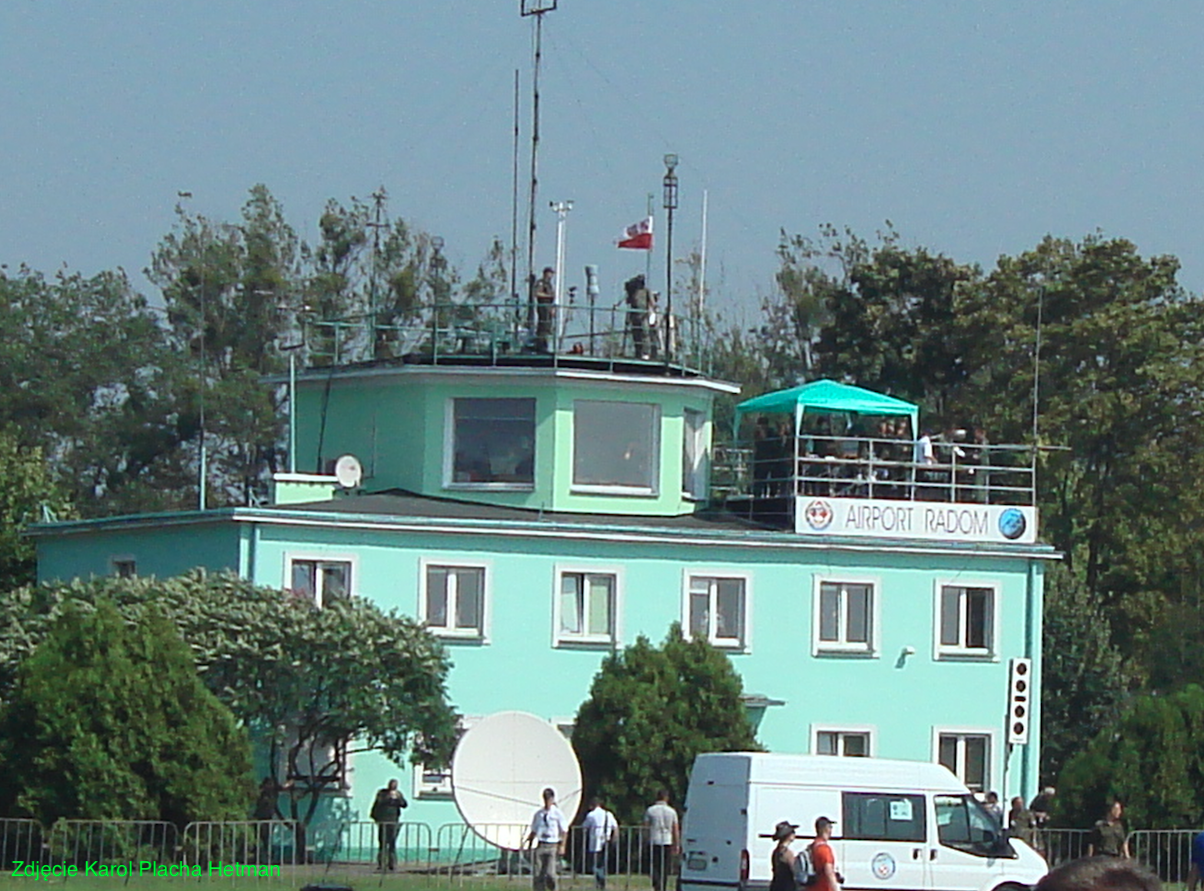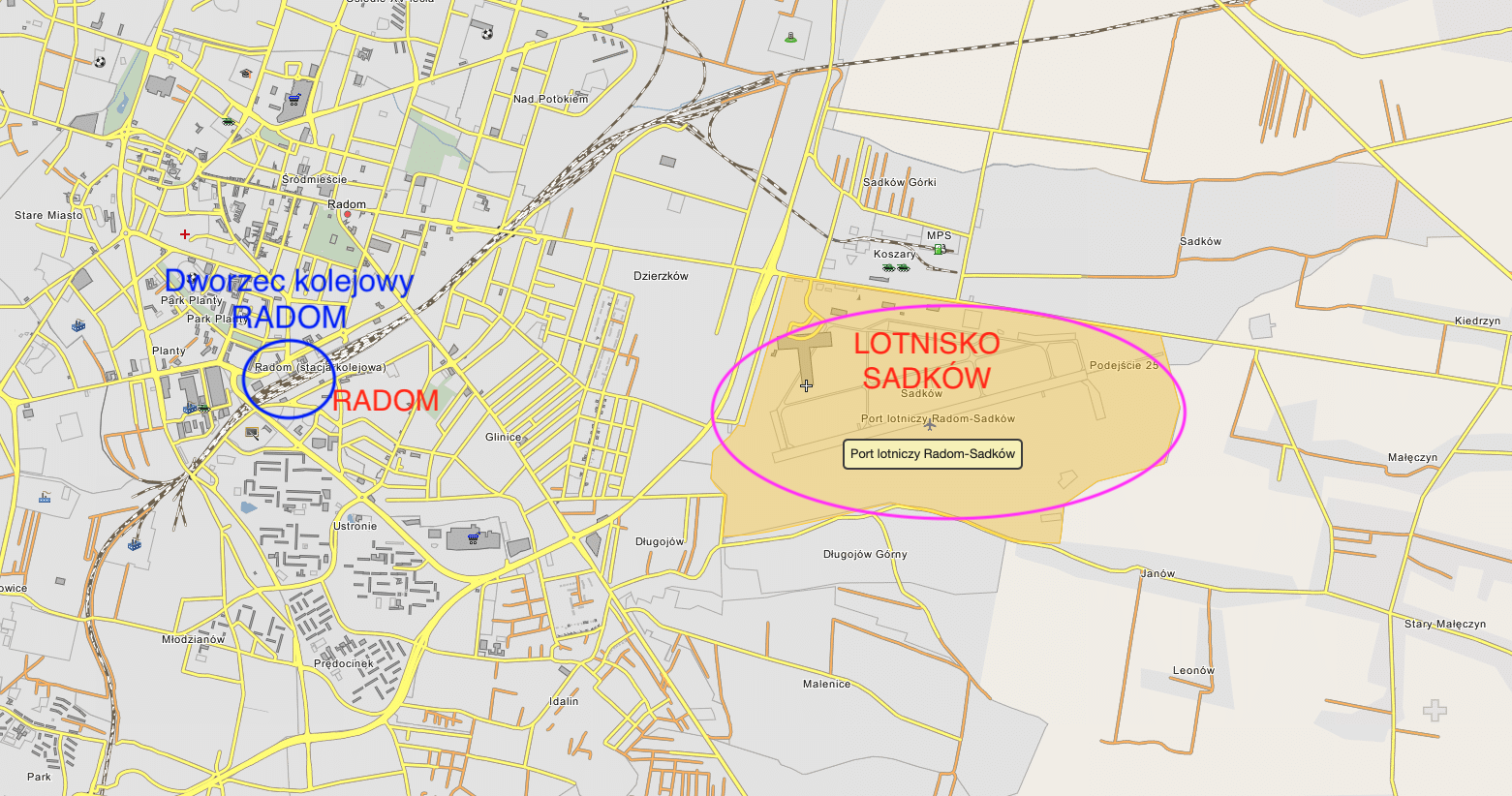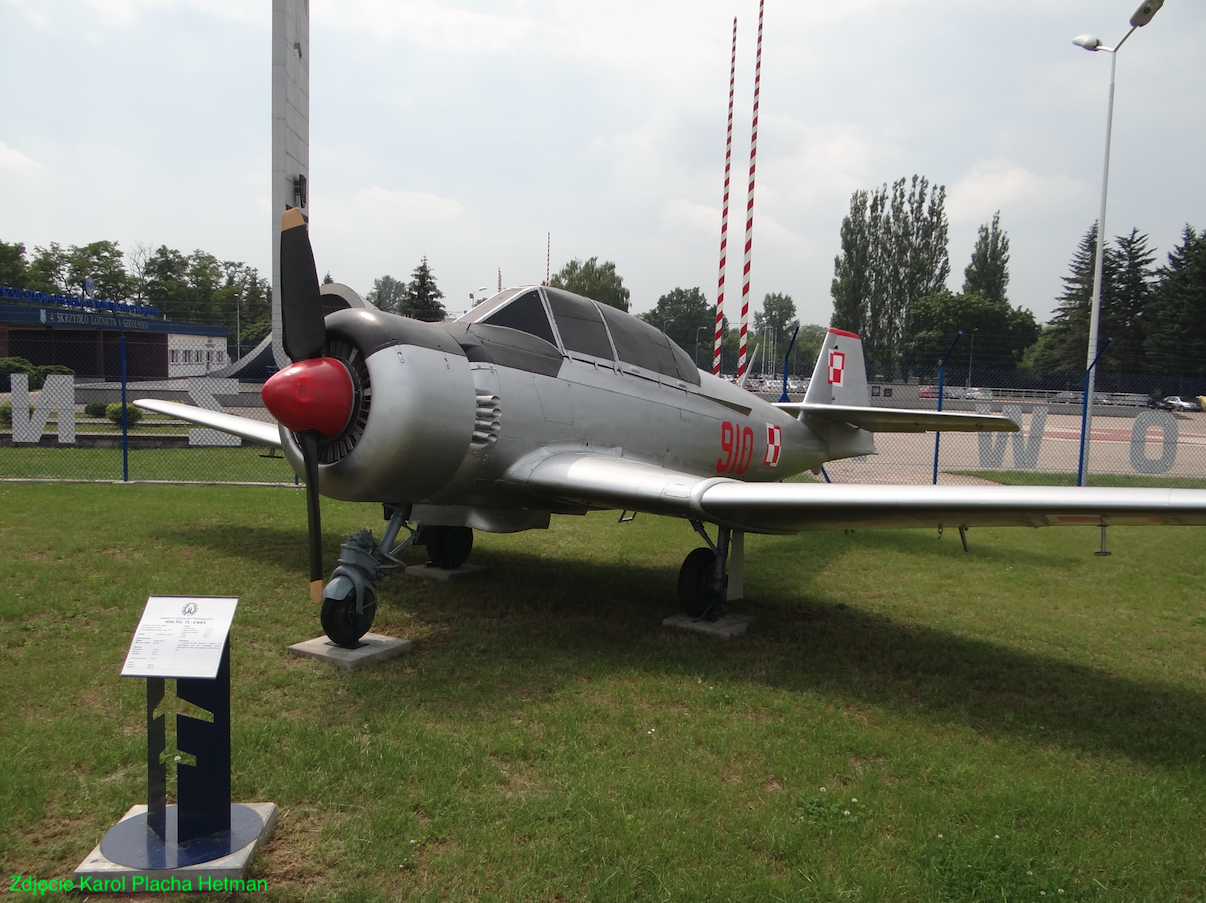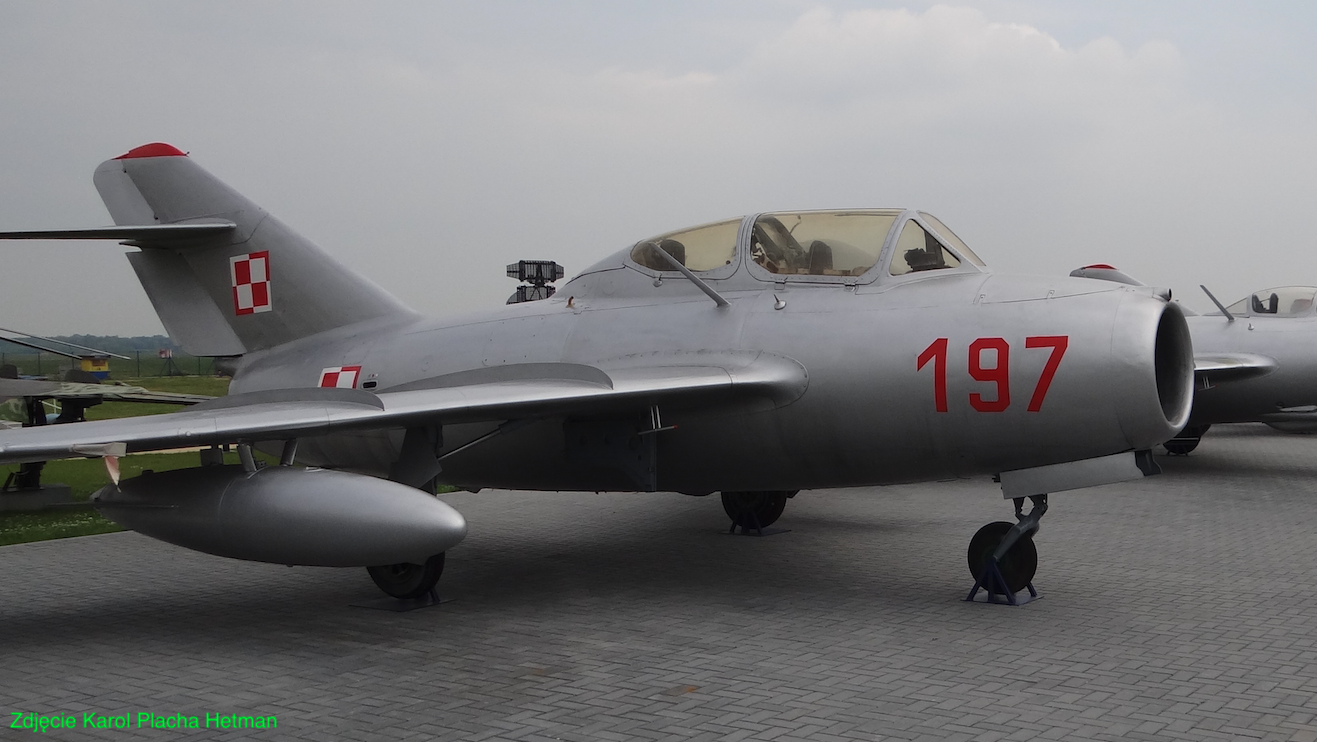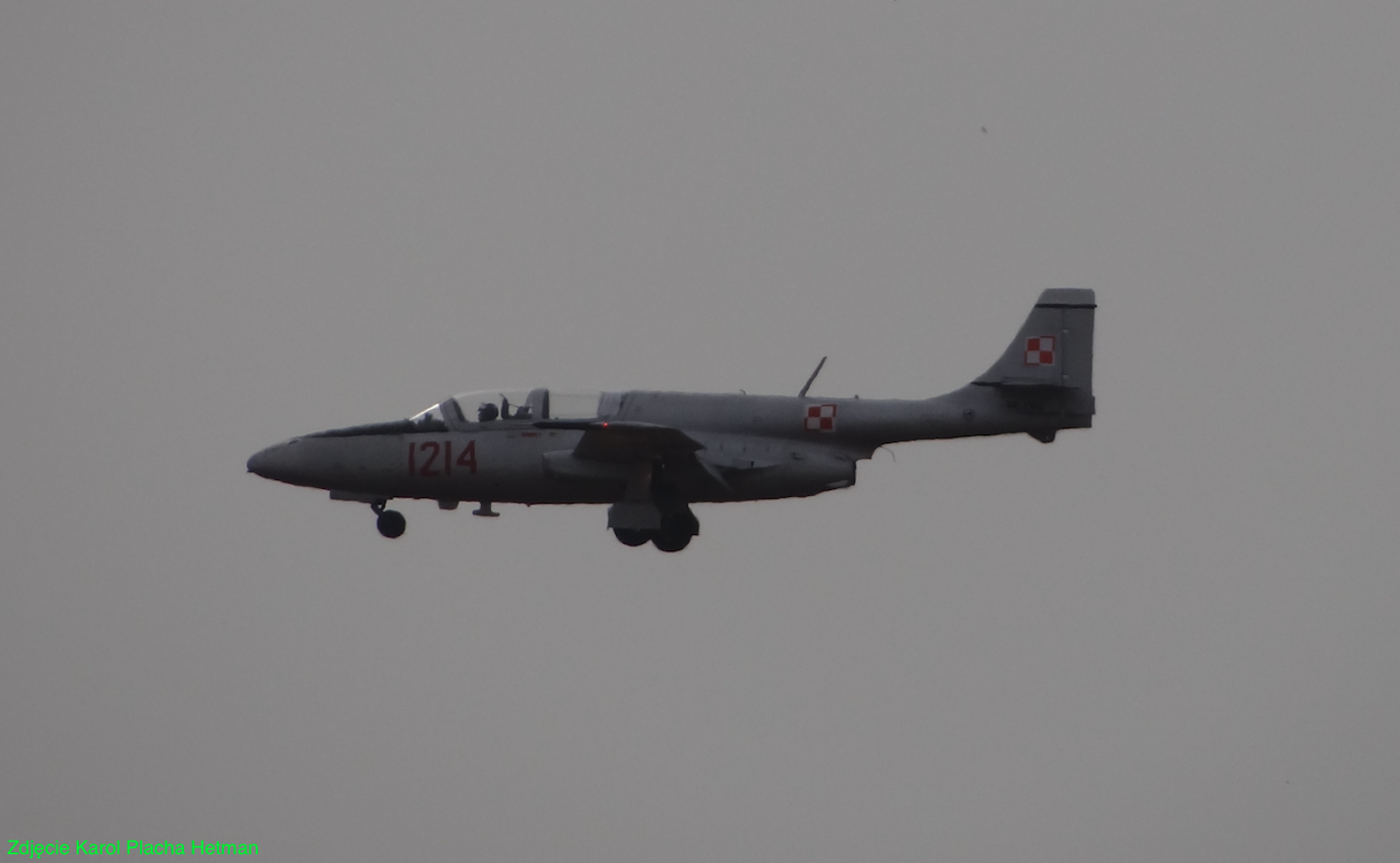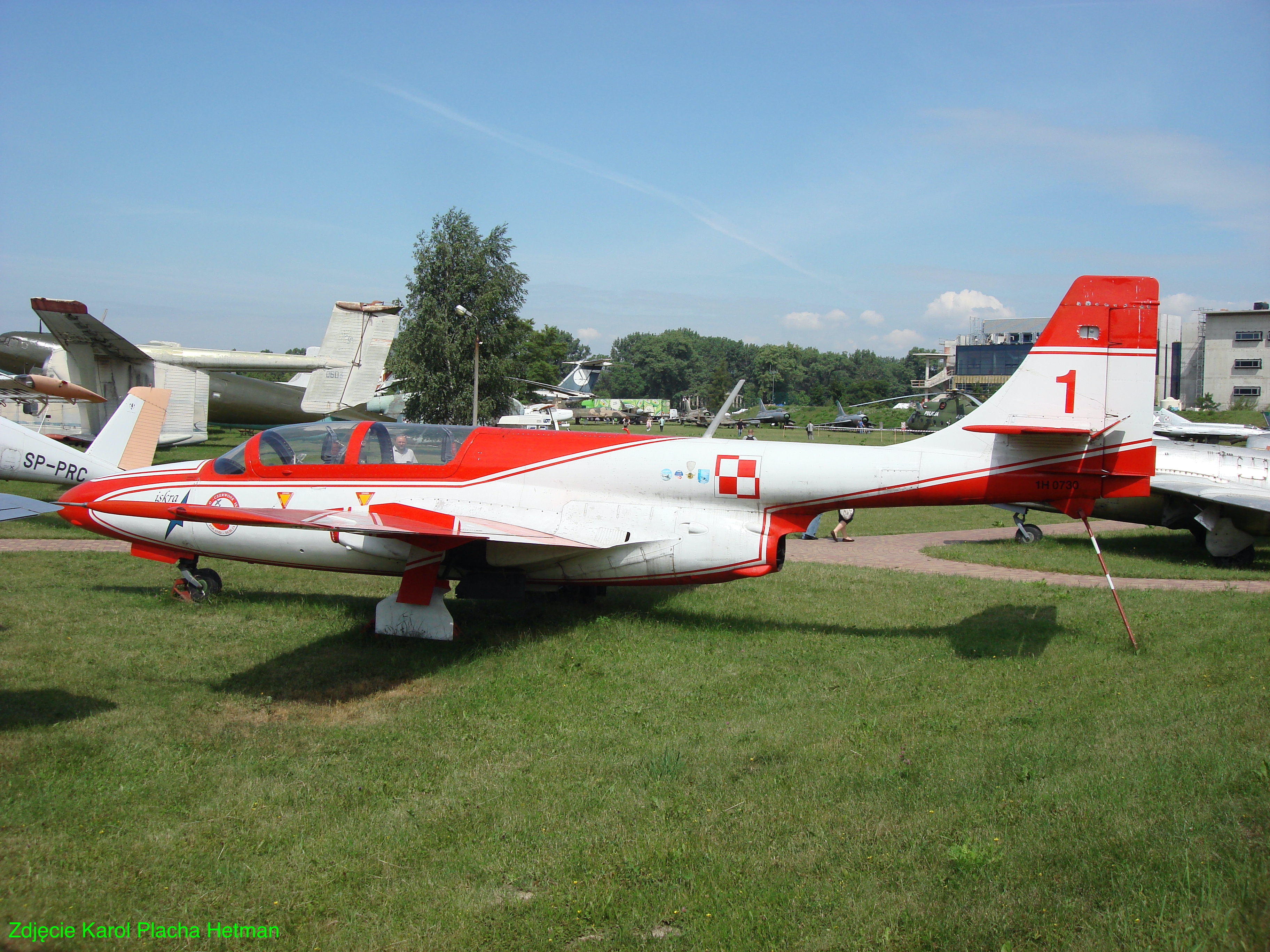Radom 2012-05-24
Airport in Radom – Sadków.
Geographic coordinates: 51.388N 21.212E.
History of Radom Sadków Airport. 1958-1989.
1958.
In 1958, there were serious organizational changes in the Polish Military Aviation. It was decided that in the School Aviation to move from the organization of Squadrons to the organization of Regiments, as it was in combat units. The intention was to facilitate the command of units, and in the event of "W", their use in combat. This concerned both the school in Dęblin No. 4 and the school in Radom No. 5. In place of the existing squadrons from May 1951, school and training and combat regiments were formed. Each regiment organizationally had two training squadrons, and each squadron had four flights.
The changes had been prepared since 1957, and appropriate orders and orders were issued. Two were the most important; Organizational order of the Ministry of National Defense No. 075/org. of December 31, 1957, and the organizational order of DWL and OPL OK No. 02/org. of January 29, 1958. As a result of the implementation of these orders, OSL 5 moved to the post of No. 20/466, forming the following air units: 60 Aviation Training and Combat Regiment in Radom, with the commander, Major Pil. Feliks Skrzeczkowski – planes: MiG-15 and MiG-15 UTI. 61 Air Training and Combat Regiment in Nowe Miasto, with the commander, Major Pil. Józef Kowalski – aircraft: MiG-15 and MiG-15UTI. 63 Air Training and Combat Regiment in Tomaszów Mazowiecki (Glinnik) with the commander, Major Pil. Kazimierz Ciepiela. Aircraft: MiG-15 and MiG-15UTI. 64 Air Training Regiment in Przasnysz, with the commander, Maj. drink Henryk Andrychowski – Junak-3, Jak-11 and TS-8 aircraft. Preparations for the reorganization had already been made earlier. At the turn of 1957/1958, the 8th Squadron was transferred from Grójec to Przasnysz.
On November 7, 1957, there was the fourth and last case of a Polish Officer escaping to the west, using a fighter from the MiG-15 family. These escapes only testify to the communist terror of the 1950s that prevailed in the People’s Republic of Poland. On the aforementioned day, November 7, 1957 (Wednesday), lieutenant pilot Bogdan Kożuchowski, from 31 PLM in Łask, hijacked the Lim-2 plane No. 1B 19-019 / 1919 to Sweden. Due to incorrect navigation, he landed inland near the town of Halland. The source materials contain information that a Swedish tourist she met persuaded the lieutenant to desert, luring her with the charms of life in the West. The naive lieutenant believed it. We believe, however, that it was an overinterpretation and glory of the communist system as the best in the world. The punishments were extremely severe and applied not only to the deserter, but also to his colleagues, superiors and family. Several people were arrested and demoted. The entire 31st PLM was severely punished. His tasks have been reoriented. Older planes replaced. However, the Poznań Uprising resulted in the easing of sanctions. Starting in 1957, court sentences applied only to escapees. Those responsible – let’s call it – were morally punished with disciplinary action, a warning, rarely a transfer to a lower position. Until the end, the prison sentence was accompanied by the deprivation of civil rights, which was painfully felt by the families left in the country. Let us not forget that Soviet citizens continued to lead the military courts.
What did all this have to do with the School in Radom? Well, the 31st PLM from a combat unit became a training and combat unit. Having lost a significant part of the staff, he was given new tasks. School this time. On April 12, 1958, the School in Radom took over the 31st PLM from Łask. It happened on the basis of DWL and OPL OK order No. 07/org. of May 22, 1958, in which the 63rd LPSzB based in Glinnik was disbanded at the same time. In the period from July 1958 to June 1960, the airport in Glinnik was not used.
By the decision of the Minister of National Defense No. 5 of December 31, 1957, and the order of the Commander of the OSL of February 5, 1958, as part of the changes in organizational structures in aviation, the 60th Air Training and Combat Regiment was established, formed on the basis of the existing 2nd and 5th Combat Pilotage School Squadron commanded respectively by: Major Lipczyński and Capt. Cymbalski. The first commander of the new regiment was Major Pil. Feliks Skrzeczkowski. Radom Airport was chosen as the base. At that time, the regiment was equipped with MiG-15 UTI, SB Lim-1, Lim-1 and Junak-3 aircraft. The personnel of the Regiment participated in various shows and exercises. One of the biggest shows in this period was the air parade with the participation of 26 pilots from Radom on October 11, 1959. It also became a review of the pilots’ level of aviation training.
1960.
The following years brought further organizational changes to the School. In accordance with the Organizational Order No. 07/org. of June 22, 1960. – 64th LPSzB based in Przasnysz was transferred to OSL 4 (Dęblin). By making further organizational changes, another school regiment was established with a base at the Glinnik airport.
Based on the same DWL Order and OPK No. 07/org. of June 22, 1960, the 66th LPSz in Glinnik was established, subordinated to OSL 5 in Radom. The Commandant of the School issued Order No. 071 of July 13, 1960, which ordered the appointed commander, Maj. drink Kazimierz Ciepiela, to form the 66th LPSz., according to the timetable 22/454, military unit of JW. 1071.
The unit was created on the basis of two school squadrons based so far in Krzewica, under the command of Capt. drink Władysław Karłowicz and in Ułęż under the command of Capt. drink Ryszard Mierzwiński. The organizational nucleus of the Regiment was the command of the supply battalion of JW. 3247 and the staff of the 2nd Air Squadron of the unit from Nowe Miasto nad Pilica, which carried out training tasks at the Glinnik airport.
In January 1960, the Regiment in Radom received a new aircraft of Polish construction, the TS-8 Bies, intended for training and training flights, which replaced the Junak-3 aircraft.
The flag of the unit, given by the resolution of the State Council of the Polish People’s Republic of October 5, 1960, was presented by the then commander of Operational Aviation, Brig. drink Jan Raczkowski, on November 29, 1960, on the 130th anniversary of the outbreak of the November Uprising.
1964.
The following years were devoted to preparations for the adoption of the Polish TS-11 Iskra jet aircraft. At the same time, training was carried out on the TS-8 Bies aircraft. The TS-11 Iskra aircraft entered service in 1964. Because Radom Airport and 60. LPSzk was the first user of these machines in the country. Therefore, the burden of developing the methodology for the operation of these modern machines fell on the staff. Thus, the whole of 1964 was devoted to the training of future instructors. Of course, together with test pilots from PZL Mielec. Cadet training began in 1965.
In 1964, the Regiment began a new phase of history. By order of the Chief of the General Staff of the Polish Armed Forces of April 8, 1964, the 60th Aviation Training and Combat Regiment was subordinated to the commander of the Officers’ Aviation School named after Janek Krasicki in Dęblin, and by order of the Chief of the General Staff of the Polish Armed Forces of December 21, 1964, – reformed into the 60th Aviation Training Regiment. This meant that the training of fighter pilots was completed (after 14 years), but basic aviation training continued. But the organizational changes were not over. In 1965, the Regiment moved to a new position.
1966.
In July 1966, the pilots of the Radom Regiment took part in the air parade over Warsaw on the occasion of the 1000th anniversary of the Polish State. During the flight on the TS-11 Iskra aircraft, they formed a formation symbolizing the white and red checkerboard.
Air shows with the participation of pilots from Radom began to be a permanent element of documenting their high aviation craftsmanship. On February 16, 1969, the regiment received the permanent task of maintaining the pilot team. The famous Rombik in Radom dates back to that day. The pilot team performed abroad – in Belgium, Great Britain, France, Hungary, the Czech Republic and Slovakia.
70s of the 20th century.
In the 70’s, the training tasks were very intense, but systematic and calm. No rapid organizational changes. Greater importance began to be attached to the health of candidates for pilots. The selection was more thorough and was carried out in Warsaw. The reason was that future pilots would drive supersonic combat machines. The level of general knowledge of the candidates was also much higher, which had a positive impact on the future of the Polish Army. Every year, several dozen WSOSP cadets from Dęblin were trained in the Regiment. The 60th Air Training Regiment was still in the service of the School in Dęblin. In Radom, training was carried out on airplanes; TS-11 Iskra, SB Lim-2, Lim-5 and Lim-6 bis.
In June 1976, there were further outbursts of public dissatisfaction with the communist authorities. The basis for this were increases in the prices of industrial and food products. Particularly strong protests took place in Radom. Tanks appeared in the streets. Blood spilled. People died. The authorities withdrew from some of the increases by introducing the first food stamps. First for sugar. Then meat, butter, sweets, alcohol, tobacco products. They went as far as the shoe cards. The cards were abolished only in 1987. The accidents in Radom stopped the process of training cadets for some time, and the unit was placed in combat readiness (against its own nation).
On January 30, 1979, a construction disaster occurred at the Radom-Sadków Airport. Under the pressure of snow, the roof of one of the hangars collapsed, damaging 26 TS-11 Iskra aircraft stored there. The winter of 1978/1979 was one of the hardest in the history of the Polish People’s Republic and was described as the Winter of the Century. Transport was paralyzed. Many factories had to stop production. All schools were closed for nearly two weeks. The destruction and damage of so many aircraft significantly disrupted the training of young pilots until the machines were replenished with aircraft from other regiments.
On December 13, 1981, Comrade General Wojciech Jaruzelski introduced martial law, declaring war on the nation and inhibiting socio-economic changes. The training process at Radom Airport has been suspended for several months. Cadets were sent in WSW (Military Internal Service) patrols to the streets. It should be remembered that in those years Radom was one of the strongest industrial centers in Poland, and the workers’ movement was extremely strong. It is enough to cite the workers’ protests of 1976. He also stopped performing and coaching the Rombik aviation team (until 1984).
1980s.
On September 29, 1983, by order of the Minister of National Defense, the 60th Air Training Regiment took the name of Capt. pilot Franciszek Żwirka and Eng. Stanisław Wigura.
Due to the liquidation in 1989 of the 66th Aviation Training Regiment in Tomaszów Mazowiecki, the local airport was transferred to the command of the Radom Regiment, which enabled the training of pilots also on this facility, until 1995, as part of the 3rd training squadron under the command of Lt. Col. Dipl. drink Zenon Mackiewicz.
In 1989, the composition of the Rombik aerobatic team was increased to 6 machines, changing its name to White-Red Sparks. It was then that the machines were painted in a characteristic white and red, extremely attractive pattern. This livery is used by the team until now (2020).
III Republic of Poland. 1989-2011 year.
On June 1-9, 1991, the Polish Pope Saint John Paul II the Great made his fourth pilgrimage to Poland. For the first time to a free Republic. He visited, among others, Radom. On June 4, 1991, he celebrated the Holy Mass in Radom. The meeting with the faithful took place on the airport apron. The Pope gave a homily addressed to the workers. The Holy Father also laid flowers at the monument commemorating the workers’ protest and victims in June 1976, at ul. June 25. The title of an honorary citizen of the City of Radom was granted to the Holy Father on August 30, 2004.
In the 1990s, 60 LPSzk carried out another equipment changeover in its history. The PZL I-22 Iryda aircraft was dedicated to replace the TS-11 Iskra. New planes were delivered to 58 LPszk, and then they were to be delivered to 60 LPszk. However, these new machines never arrived in Radom. In 1996, all the I-22 Irydas delivered to the army so far were returned to Mielec.But at the same time, a new type of training aircraft, the PZL-130 Orlik, began to be introduced to training in the Republic of Poland. The aircraft, which is a transition between a piston aircraft (basic) and a training and combat aircraft with a turbojet drive, is the PZL I-22 Iryda. The first PZL-130 Orlik aircraft was put into operation in Radom in 1994.
At the end of 1997, the last TS-11 Iskra aircraft were withdrawn from Radom Airport. Some of them were transferred to Dęblin, and the rest were taken out of stock due to the end of their service life.
In March 1998, the Orlik Aerobatic Team was established, using PZL-130 Orlik aircraft. It happened on the basis of the Order of the Commandant of the School of Eaglets in Dęblin of January 1, 1998. The team received 4 machines, plus one for an individual show. Training began on April 15, 1998. The team presented their skills for the first time at the largest air show in the world at the time, Air International Tattoo in Faiford, Great Britain. A series of successful demonstrations saw the team grow to seven machines. In the following years, he graced with his presence national shows in Dęblin, Radom and international shows in the Czech Republic, France, Great Britain, Lithuania and Slovakia. In 2001, the team was expanded to seven machines, and two years later (2003) to nine.
2000.
In 1999, the Republic of Poland joined the NATO system. This resulted in a number of reorganizations and reforms of individual units. In 2000, 60 LPSzk underwent structural changes. Officially, on December 28, 2000, the 60th Air Training Regiment was liquidated. On that day, in one of the hangars, a farewell ceremony was held for the flag, which was handed over to the Polish Army Museum.
From January 1, 2001, by order of the Chief of the General Staff of the Polish Armed Forces, the 2nd Aviation Training Center and the No. 2 Airport Command were established on the basis of 60 LPSzk. Both as sub-units within the structures of the 6th Air Base in Dęblin. The first commander of the center was Col. Dipl. drink Marek Bylinka, while the command of the airport is Major Sławomir Grychtal.
During its existence, 60 LPSzk was awarded many times. Some of the regiment’s awards and distinctions: Commander’s Cross of the Order of Polonia Restituta. medal "For Outstanding Achievements in Military Service", numerous cups for flight safety. Commanders of the 60th LPSzk.
For 42 years of the Regiment’s existence, it was led by the following commanders: Lt. Col. Dipl. drink Feliks Skrzeczkowski, Lt. Col. Dipl. drink Marian Lipczyński, Lt. Col. Dipl. drink Stanisław Madej, Lt. Col. Dipl. drink Franciszek Maciola, Lt. Col. Dipl. drink Ryszard Olszewski, Col. Dipl. drink Ryszard Leszczyński, Col. Dipl. drink Boguslaw Deja, Col. pil. dr Marek Bylinka – also the first commander of the 2nd OSL.
2001.
In 2000, as a result of transformations in the Air Force, the Biało-Czerwone Iskry aerobatic team was redeployed to Dęblin, with its symbolic transfer on June 17, 2000.
In the fall of 2001, the 2nd OSzL obtained permission to have the banner. The award ceremony took place on November 10, 2001 in Radom. Since March 23, 2003, the center has been commanded by Col. Dipl. drink Jerzy Chojnowski, who is also the commander of the Radom Garrison.
2004.
In June 2004, the Airport Command No. 2 was reformed. In place of the existing sub-unit, an independent Air Force logistics unit was established under the name of the 1st Airport Command (JW. 3463). Officially, the 1st Airport Headquarters has been operating since July 1, 2004. However, the Command’s independence was short-lived, as it was subordinated to the Air Force Academy in Dęblin.
2 Aviation Training Center in Radom named after Capt. drink Franciszek Żwirka and Eng. Stanisław Wigura was a training unit of the Air Force. He was involved in practical training on PZL-130 Orlik aircraft for cadets of the Air Force Academy in Dęblin and kept the Orlik aerobatic team ready for demonstrations. First and second year cadets were trained. The flying period started at the beginning of March. Students came to Radom as early as February to consolidate their theoretical knowledge about piloting the PZL-130 Orlik aircraft and perform flights on the simulator for the first month. After the theoretical exam, they started their first flights on the PZL-130.
The 1st Airport Headquarters in Radom, on the other hand, was the logistics unit of the Air Force and secured the training in terms of logistics. 2 OSzL and 1 KL were military units that were part of the 4th Training Aviation Wing in Dęblin.
This not entirely transparent division of functions resulted in frequent duality of functions and sometimes a lack of competence. As a result, an agreement had to be concluded that fine-tuned the competencies. At the same time, it made it possible to undertake joint actions for the benefit of the civilian environment. It was possible to extend the military patronage to school classes with a military profile in ZDZ schools (Związek Improvement Zawodowego) in the Mazowieckie Voivodship in Radom and Nowe Miasto. Between these institutions and the ZDZ Branch in Radom, a cooperation agreement was signed to promote defence, military education and professional military service, bringing students of "military" classes of ZDZ schools closer to the implementation of plans for future work in the Polish Army, and in particular in the Polish Air Force. The agreement of the partners covered the organization of conferences, military ceremonies and training. Festivals, tournaments, competitions, Spartakiads, as well as a number of other mass events popularizing the traditions of patriotic and military education. The military didactic staff provided teachers from ZDZ schools with substantive assistance in conducting classes on the Armed Forces and specialist problems. The military provided information and education materials, training materials and materials promoting military education as well as illustrative materials. They also helped conduct classes related to defense in the military unit.
The tasks of the 1st Airport Command (JW. 3463) included; Maintaining and restoring the technical efficiency of armaments and military equipment. Gathering (storage), supplying and planning material deliveries for the needs of subdivisions. Maintaining and restoring the operational readiness of the Airport (infrastructure maintenance). The 1st Airport Command celebrated its holiday on July 1. They were established by Decision No. 350/MON of August 3, 2007.
Commanders of the 1st Command of the Radom Sadków Airport; Colonel pilot Jerzy Chonowski – July 1, 2004-June 5, 2006 Lieutenant Colonel Krzysztof Baranowski, MA – June 5, 2006 – December 31, 2010 The last commanders in the 1st Headquarters of the Radom Sadków Airport. Lieutenant Colonel Krzysztof Baronowski, MA – commander from June 5, 2006 to December 31, 2010. Major Jacek Jaźwic – deputy commander. Major Janusz Orzechowski – Chief of Staff Major Marek Ziębicki – Chief of Logistics. Major Andrzej Wójtowicz – head of the Training. Subordination – Air Force Academy – July 1, 2004 – December 17, 2008 then the 4th Training Aviation Wing – December 17, 2008 – December 31, 2010.
1 The Radom Airport Headquarters secured the tasks; 2 Aviation Training Centres, 4 WOM (Military Meteorology Centre), Military Replenishment Headquarters in Radom, Military Specialist Medical Clinic (WSPL), Psychological Workshops, Regional Military Representation, Military Police Post (ŻW), Military Housing Agency (WAM).
2011.
Within a dozen or so months, further organizational changes took place, confirming the collapse of the Polish Armed Forces. Pursuant to the decision of the Minister of National Defense (weak minister Bogdan Kich, dismissed on August 2, 2011, as a result of accidents related to the Smolensk attack), the 2nd Aviation Training Center and the 1st Airport Headquarters were reformed on January 1, 2011, into the 42nd Training Aviation Base.
Therefore, according to the "Military Ceremony of the Polish Armed Forces", on December 10, 2010, a ceremonial farewell to the banners of the 2nd OSzL and 1st KL took place at the military airport in Radom. The new commander of the 42nd Training Aviation Base, Colonel Adam Ziółkowski, gave a speech and thanked all soldiers and army employees for their service so far, but also outlined the tasks and challenges facing the new unit. The ceremony of farewell to the banners ended with the signing of the act of reforming the units in the Hall of Tradition of the Radom Garrison. This symbolic act was attended by: unit commanders, banner bearers, banner founders, representatives of the region’s administrative and local government authorities, military chaplaincy, non-governmental organizations and veterans’ circles. The military appeal was honored by the Air Force Representative Company and the Air Force Garrison Band from Radom.
Polish Aviation Units in Radom, summary:
School Squadron of Pilots 1927-1935 Reserve Pilot School 1935-1939 Air Force Reserve Cadet School 1937-1939 The occupation period of the German army 1939-1945. 15th Reserve Aviation Regiment with headquarters in Dęblin 1945-1951. Officers’ Aviation School No. 5 Żwirki i Wigury 1951-1964 60 Aviation Training and Combat Regiment 1958-1964 Officers’ Aviation School subordinated to the School in Dęblin 1964-1968. 60 Aviation Training Regiment 1964-2000 Higher Aviation Officers’ School subordinated to the School in Dęblin 1968-2000. Aviation Training Center subordinated to the School in Dęblin 2000-31.12.2010. Airport Headquarters No. 2 as a logistics sub-unit in the structures of the 6th Air Base in Dęblin, 2000-2004. 1st Airport Headquarters (JW. 3463) July 1, 2004 – December 31, 2010 42 Air Training Base 1.01.2011-…
Adres; Lotnisko Radom Sadków. Ulica Lubelska 150, 26-600 Radom. Telefony; 48-351-1290, 48-351-1330, faks 48-351-1555.
Air Show Radom.
Since 2000, great military and civil air shows have been organized at the Radom Sadków airport. Air Shows in the Republic of Poland are great aviation events, the main organizer of which is the Polish Military Aviation, now known as the Polish Air Force. The main feature of these shows is the participation of foreign guests, mainly representatives of military aviation. These events are always associated with the celebration of the Polish Aviation Day (celebrated on August 28). The aim of the International Air Show is to bring the nation closer to the realities of aviation life of those who defend the Polish Sky. Their training, training and combat missions. Demonstrating the Polish side against the background of other countries, not always very favorable to us. Demonstration of the art of air combat, the craftsmanship of higher pilotage, and even circus performances. Everything that the viewer is supposed to see on the ground and in the air is thought out, carefully planned and arranged. There are no two identical shows. Each has its own specifics.
Air Shows in Free Poland were initially organized irregularly and at various airports. It was not until 2000 that the Radom-Sadków Airport became a permanent venue, and since 2003, the event has been held regularly, every two years.
The first Air Show event (I) took place in 1991 at Ławica Airport. The next Air Show II was organized only in 1995, at the Dęblin Airport. Air Show III was organized in 1996 at the Bydgoszcz Airport. Air Show IV was held again at Dęblin Airport in 1998. In 2000, Air Show V was held for the first time at Radom Airport. In 2001, Air Show VI Radom. In 2002, Air Show VII Radom. In 2003, Air Show VIII Radom. Then every two years. In 2005, Air Show IX Radom. In 2007, Air Show X Radom. In 2009, Air Show XI Radom. In 2011, Air Show XII Radom. In 2013, Air Show XIII Radom. In 2015, Air Show XIV Radom. In 2017, Air Show XV Radom (this event was not supposed to take place, but Minister Antoni Macierewicz kept his word). In 2018, Air Show XVI Radom (this event was on the occasion of the 100th anniversary of regaining independence by Poland). There was no event in 2020 because of the corona virus pandemic.
At this point, it should be noted that in other years events were also organized, which were sometimes referred to as Air Shows, but were not included in this series. They were organized in Bydgoszcz, Dęblin, Gdynia and Mielec. More on this in separate chapters and articles.
Written by Karol Placha Hetman

